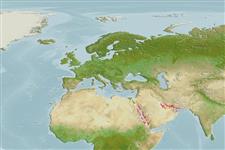Classificatie / Names
Lokale namen | Synoniemen | Catalog of Fishes(Genus, Soort(en)) | ITIS | CoL | WoRMS | Cloffa
>
Gobiiformes (Gobies) >
Gobiidae (Gobies) > Gobiinae
Etymology: nanus: Name from the Latin 'nanus' meaning small or dwarf, referring to the species' small size among Coryogalops species..
Environment: milieu / climate zone / depth range / distribution range
Ecologie
marien; diepte 1 - 3 m (Ref. 116571). Tropical
Western Indian Ocean: Red Sea, Saudi Arabia and Egypt .
Grootte / Gewicht / Leeftijd
Maturity: Lm ? range ? - ? cm
Max length : 1.5 cm SL mannelijk / geslacht onbekend; (Ref. 116571)
Korte beschrijving
Morfologie | Morfometrie
Dorsale stekels (totaal): 7; Dorsale zachte stralen (totaal): 10; Anale stekels 1; Anale zachte stralen: 9. This species is distinguished by the following characters: D VI + I,10; A I,9; pectoral-fin rays 12?14, the 2 upper rays with free tips; pelvic fins I,5, joined to form a disc which is emarginate (the shortest branches of fifth ray about 2/3?3/4 length of longest branches of fourth ray), no pelvic frenum; naked predorsal area and area at base of first dorsal fin; longitudinal scale series 26-29; transverse scale series counted forward 6-7, reaching naked area at first dorsal-fin base; transverse scale series counted backward 7-8; circumpeduncular scale rows 11-12; head with 7 transverse suborbital rows of sensory papillae; without tentacle above upper eye margin; anterior nostril is tubular, without flap at its tip, posterior nostril pore-like; semi-translucent body with small scattered orange-yellow spots and speckles, spots in predorsal area and a few midlaterally on body containing black dots; ventral part of body with a row of internal white spots above anal-fin base and on caudal peduncle; head and prepectoral area with small scattered orange to yellowish brown spots; first dorsal fin with 2 broad white bands at the base of fin and distally, middle of fin hyaline densely dotted with melanophores; colour of preserved specimen opaque white to yellowish with sparse melanophores (Ref. 116571).
This species were collected on a patch of rubble-sand bottom in less than one meter to 3 meters deep; found among shells sparsely covering the patch. More material and data are needed to check the relationship of this species to shells and their use as shelters (Ref. 116571).
Levenscyclus en paargedrag
Maturiteit | Voortplanting | Paaien | Eieren | Fecunditeit | Larven
Kovačić, M., S.V. Bogorodsky and A.O. Mal, 2016. A new species of Coryogalops (Perciformes: Gobiidae) and the first adult record of Feia nympha from the Red Sea. Zootaxa 4097(3):341-352. (Ref. 116571)
Status op de Rode Lijst van het IUCN (Ref. 130435)
Gevaar voor de mens
Harmless
Gebruik door de mens
Meer informatie
Lokale namenSynoniemenMetabolismePredatorenEcotoxicologieVoortplantingMaturiteitPaaienPaaiaggregatiesFecunditeitEierenOntwikkeling van de eieren
Leeftijd/GrootteGroeiLengte-gewichtLengte-lengteLengtefrequentiesMorfometrieMorfologieLarvenLarvale populatiedynamiekRekruteringAbundantieBRUVS
ReferentiesAquacultuurAquacultuurprofielKweeklijnenGeneticaElectrophoresesErfelijkheidZiektesVerwerkingNutrientsMassaconversie
Tools
Speciale rapporten
Download XML
Internetbronnen
Estimates based on models
Fylogenetische diversiteitsindex (Ref.
82804): PD
50 = 0.5002 [Uniqueness, from 0.5 = low to 2.0 = high].
Bayesian length-weight: a=0.00708 (0.00333 - 0.01504), b=3.09 (2.92 - 3.26), in cm total length, based on LWR estimates for this (Sub)family-body shape (Ref.
93245).
Trofisch niveau (Ref.
69278): 3.0 ±0.3 se; based on size and trophs of closest relatives
Weerstandsvermogen (Ref.
120179): Hoog, minimale populatieverdubbelingstijd minder dan 15 maanden (Preliminary K or Fecundity.).
Fishing Vulnerability (Ref.
59153): Low vulnerability (10 of 100).
